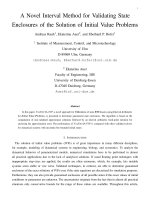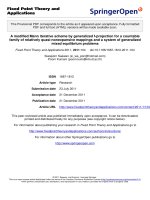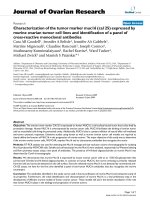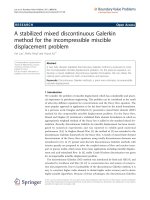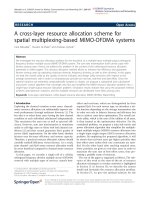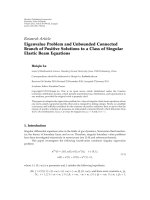A Development of Novel Integral Method for Prediction of Distorted Inlet Flow Propagation_2 docx
Bạn đang xem bản rút gọn của tài liệu. Xem và tải ngay bản đầy đủ của tài liệu tại đây (400.34 KB, 10 trang )
4.3.2 Inlet Distorted Velocity Coefficient
According to the Chap. 1, the inlet distorted velocity coefficient and incident angle
are the essential parameters affecting the inlet distortion propagation. Firstly, the
effect of variation in inlet distorted velocity coefficient,
)0(
α
, is analyzed here to
show what role does it play in the current novel integral method.
To facilitate in discussion of distortion quantitatively, a distortion level is de-
fined as:
)x(
)x(
1)x(
0
α
α
Γ
−=
(4.27)
The smaller
)0(
α
means higher inlet distortion level. It is obvious that the defini-
tion of distortion level in representing the relative distortion is more intuitive than us-
ing the distorted velocity coefficient. For example, the case with
0.1)0(
0
=
α
and
1.0)0( =
α
, the distortion level at inlet is
9.0)0(
=
Γ
. This is a severe distortion case
with a high initial distortion level. While
0.1)0(
=
α
will result in a
0.0)0( =
Γ
, and
hence zero distortion.
x
ξ
0.00.20.40.60.81.0
0.4992
0.4996
0.5000
0.5004
α(0)=0.3
α(0)=0.5
α(0)=0.7
α(0)=0.3
α(0)=0.5
α(0)=0.7
ο
θ=15
ο
Ng et al.
Kim et al.
Fig. 4.4. A comparison of distorted flow propagation between the results of Ng
et al.[11] and that of Kim et al. [6]
Figure 4.4 shows that the previous work (in Chap. 1) is in good agreement with
that of Kim et al. [6], which indicates that the propagation of inlet distortion with a
bigger inlet distortion level will grow and vice-versa. However, the results using
the present novel integral method suggest a different conclusion. From Fig. 4.5,
the novel method provides a more serious propagation of inlet distortion. On the
4.3 Results and Discussion 87
other hand, unlike the cases in Fig. 4.4, the present results indicate that for any
inlet distortion level, the size of distorted region will grow along x-direction. In
other word, using a force with simplified assumption, the integral method would
underestimate the propagation of inlet distortion.
Figure 4.5 indicates that a distorted region size will increase with an increasing of
distortion. Higher inlet distortion level (or smaller inlet distorted velocity coeffi-
cient) results in a more severe propagation of distortion.
x
ξ
0246810
0.49
0.50
0.51
0.52
0.53
0.54
α=1.0
α=0.9
α=0.7
α=0.5
α=0.3
α=0.7
α=0.5
α=0.3
(no distortion)
θ(0)=15
ο
ο
Ng et al.
Current
Fig. 4.5. The inlet distortion propagates along axial direction with different inlet
distortion level
4.3.3 Inlet Incident Angle
To study on extreme case, a higher inlet distortion level (
9.0
)0(
=
Γ
, or
1.0)0( =
α
) is fixed during the analysis for variation in distortion with different
inlet incident angles.
Chapter 4 A Development of Novel Integral Method 88
89
x
ξ
0246810
0.48
0.49
0.50
0.51
0.52
0.53
0.54
0.55
0.56
0.57
θ=1
θ=5
θ=10
θ=15
θ=20
θ=25
o
o
o
o
o
o
o
o
o
o
o
o
α(0)=0.1
Fig. 4.6. The inlet distortion propagates along axial direction at smaller inlet inci-
dent angles,
°≤ 25
0
θ
The calculation shows that the inlet distortion will grow for a multistage com-
pressor in any inlet incident angle. However, this growing magnitude is not a mo-
notonous function of inlet incident angle only. The increment of distorted region
size at outlet,
)10x( =
ξ
, will decrease with the increasing of inlet incident angle
before about
°= 25
0
θ
, and then will increase with the increasing of incident angle.
Therefore, the results are presented in two figures: Fig. 4.6 and Fig. 4.8.
4.3 Results and Discussion
x
β
0246810
1
2
3
4
5
6
θ=1
θ=5
θ=10
θ=15
θ=20
θ=25
o
o
o
o
o
o
o
o
o
o
o
o
α(0)=0.1
Fig. 4.7. The vertical distorted velocity coefficient propagates along axial direc-
tion at smaller inlet incident angles,
°
≤
25
0
θ
x
ξ
0246810
0.50
0.55
0.60
0.65
0.70
θ=30
θ=35
θ=40
θ=45
θ=50
θ=55
θ=60
o
o
o
o
o
o
o
o
o
o
o
o
o
o
α(0)=0.1
Fig. 4.8. The inlet distortion propagates along axial direction at higher inlet inci-
dent angles,
°≥ 25
0
θ
Chapter 4 A Development of Novel Integral Method 90
91
x
β
0246810
0.1
0.2
0.3
0.4
0.5
0.6
0.7
0.8
θ=30
θ=35
θ=40
θ=45
θ=50
θ=55
θ=60
o
o
o
o
o
o
o
o
o
o
o
o
o
o
α(0)=0.1
Fig. 4.9. The vertical distorted velocity coefficient propagates along axial direc-
tion at higher inlet incident angles,
°≥ 25
0
θ
4.3.4 Propagation of Distortion Level
The inlet distortion varying along axial direction with different inlet velocity coeffi-
cients or inlet flow angles has been investigated. However, what would be
observed from the viewpoint at outlet for a ten-stage compressor with different
inlet velocity coefficients, inlet flow angles or inlet distorted region sizes?
Figure 4.10 and Fig. 4.11 indicate that the outlet size of distorted region is larger
for a case with higher inlet distortion level regardless of what the inlet size of
distorted region is. On the other hand, for a case with higher inlet distortion
level, the radius of curvature of outlet size of distorted region tends to be in-
creased whatever the inlet size of distorted region is.
4.3 Results and Discussion
In Fig. 4.6, smaller inlet incident angle induces a larger propagation of inlet dis-
tortion. Because a small inlet incident angle induces a large vertical flow in dis-
torted region as shown in Fig. 4.7, thus induces a small axial distorted velocity
coefficient from (4.24b), and then a large size of distorted region from (4.25). On
the contrary, when the inlet incident angle grows to a large value,
°°
=
30~25
0
θ
in the current case, the increment of distorted region size at outlet will increase
with the increasing of the inlet incident angle as shown in Fig. 4.8. This is because
with a larger inlet incident angle, the vertical flow in distorted region tends to de-
crease (Figure 4.9).
θ
ξ (10)
0 1020304050607080
0.50
0.55
0.60
0.65
0.70
0.75
0.80
0.85
α(0)=0.1
α(0)=0.7
α(0)=0.9
o
ξ(0)=0.5
Fig. 4.10. The predicted outlet size of distorted region vs.
0
θ
with higher inlet size
of distorted region of 0.5
θ
ξ (10)
0 1020304050607080
0.10
0.20
0.30
0.40
0.50
0.60
0.70
0.80
α(0)=0.1
α(0)=0.7
α(0)=0.9
o
ξ(0)=0.1
Fig. 4.11. The predicted outlet size of distorted region vs.
0
θ
with smaller inlet
size of distorted region of 0.1
Chapter 4 A Development of Novel Integral Method 92
93
α
(
0
)
ξ
0.0 0.1 0.2 0.3 0.4 0.5 0.6 0.7 0.8 0.9 1.0
0.50
0.51
0.52
0.53
0.54
0.55
0.56
θ=5
θ=15
θ=25
(10)
Ο
Ο
Ο
Ο
Ο
Ο
ξ(0)=0.5
Fig. 4.12. The predicted outlet size of distorted region vs.
)0(
α
with higher inlet
size of distorted region of 0.5
4.3 Results and Discussion
When inlet flow angle is very small, the outlet size of distorted region will de-
crease with the decreasing of inlet distortion level. With the increase of inlet
flow angle, the peak point of outlet size of distorted region will move forward
along
)0(
α
axes (Figure 4.12 and Fig. 4.13). In other words, the peak point of
)10(
ξ
corresponds to an increased value of
)0(
α
at a higher inlet flow angle.
α
(
0
)
ξ
0.0 0.1 0.2 0.3 0.4 0.5 0.6 0.7 0.8 0.9 1.0
0.10
0.12
0.14
0.16
0.18
0.20
0.22
θ=5
θ=15
θ=25
(10)
Ο
Ο
Ο
Ο
Ο
Ο
ξ(0)=0.1
Fig. 4.13. The predicted outlet size of distorted region vs.
)0(
α
with smaller inlet
size of distorted region of 0.1
To ease in comparing the results between different inlet sizes of distorted re-
gion, we define the level of distortion propagation by the difference between the
sizes of outlet and inlet distorted regions such as
[
]
)0()10(
ξ
ξ
−
in the current
case. With this definition, we can arrange the results with different inlet sizes of
distorted region in a single plot as shown in Fig. 4.14 and Fig. 4.15. Both figures
Chapter 4 A Development of Novel Integral Method 94
illustrate that for a higher inlet flow angle, more severe distortion propagation oc-
curs with a larger inlet size of distorted region. On the contrary, for a lower inlet
flow angle with
°≤ 25
0
θ
, a higher level of distortion propagation occurs with a
smaller inlet size of distorted region
)0(
ξ
.
95
θ
ξ (10) − ξ (0)
0 1020304050607080
0.00
0.10
0.20
0.30
0.40
0.50
0.60
α(0)=0.1,ξ(0)=0.1
α(0)=0.7,ξ(0)=0.1
α(0)=0.9,ξ(0)=0.1
α(0)=0.1,ξ(0)=0.5
α(0)=0.7,ξ(0)=0.5
α(0)=0.9,ξ(0)=0.5
o
Fig. 4.14. The level of distortion propagation versus inlet flow angle
α
(
0
)
ξ (10) − ξ (0)
0.0 0.1 0.2 0.3 0.4 0.5 0.6 0.7 0.8 0.9 1.0
0.00
0.02
0.04
0.06
0.08
0.10
0.12
θ=5, ξ(0)=0.1
θ = 15 , ξ (0) = 0.1
θ = 25 , ξ (0) = 0.1
θ=5, ξ(0)=0.5
θ = 15 , ξ (0) = 0.5
θ = 25 , ξ (0) = 0.5
Ο
Ο
Ο
Ο
Ο
Ο
Ο
Ο
Ο
Ο
Ο
Ο
Fig. 4.15. The level of distortion propagation versus inlet distorted velocity coefficient
4.3 Results and Discussion
4.3.5 Compressor Characteristics
The total pressure ratio and the static pressure rise of compressor are investi-
gated to study the effects of inlet parameters on the compressor performance
and characteristics.
θ
0 10203040506070
0.8
1.0
1.2
1.4
1.6
1.8
2.0
α(0)=0.1,ξ(0)=0.1
α(0)=0.7,ξ(0)=0.1
α(0)=0.9,ξ(0)=0.1
α(0)=0.1,ξ(0)=0.5
α(0)=0.7,ξ(0)=0.5
α(0)=0.9,ξ(0)=0.5
o
P
02
___
P
01
Fig. 4.16. The computed compressor total pressure ratio versus inlet flow angle
Chapter 4 A Development of Novel Integral Method 96
Figure 4.16 indicates that a smaller inlet flow angle causes a higher total pres-
sure ratio, and a smaller inlet distorted velocity coefficient
)0(
α
, or a higher inlet
distortion level
)0(
Γ
induces a higher total pressure ratio. However, the inlet size
of distorted region has no obvious effect on the total pressure ratio.
